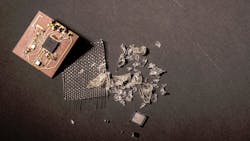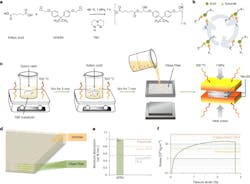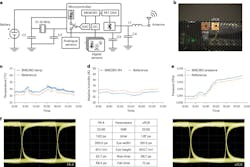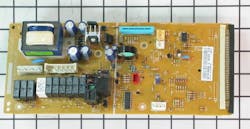Look Out, FR-4: Recyclable PCBs May be Coming After You
What you’ll learn:
- The recycling challenges posed by conventional glass-epoxy PCBs such those using FR-4.
- How a new material and process offers easy and high-performance PCB recycling and component recovery.
- How PCBs using the new material offer performance comparable to FR-4.
The go-to choice for most printed-circuit-board (PCB) laminate is known as FR-4, widely used and suitable for most applications. Not only can you get the basic material from multiple sources, but PCB fabrication houses know how to work with it to create multilayer boards with tight tolerances, and its mechanical and electronic specifications are fully defined.
FR-4 and most other PCB laminates use a combination of woven glass and thermoset epoxy that has been irreversibly cured, offering mechanical strength, consistency, and ruggedness as well as electrical performance.
Nonetheless, there’s one unavoidable fact about FR-4: It’s almost impossible to recycle or reuse. Billions of pounds of circuit boards and their components are “tossed” every year, admittedly with some efforts at covering any precious metals.
Vitrimer-Based Boards as a Sustainable Alternative
Now, a team at the University of Washington (Seattle) has developed a circuit-board laminate based on a material that’s easily recycled and can even be reused. And they maintain it has performance comparable to FR-4.
Researchers used a type of vitrimer that’s easily transformed to a jelly-like substance without damaging it, while also allowing the solid components to be plucked out for reuse or recycling as well (Fig. 1).
What’s a vitrimer? Vitrimers are a class of polymers first developed in 2015. When exposed to certain conditions such as heat above a specific temperature, their molecules can rearrange and form new bonds (Fig. 2). This makes them both “healable” (a bent PCB could be straightened, for instance) and highly recyclable. Their vitrimer-based boards (dubbed vPCB) aren’t limited to basic single-layer single/double-sided PCBs—they can have multiple layers, the same as FR-4 boards.
The vitrimer jelly can then be repeatedly used to make new, high-quality PCBs, unlike conventional plastics that degrade significantly with each recycling. Because vitrimers can form new bonds, researchers laminated fully cured vPCB layers.
The researchers found that to recycle the vPCBs, they could immerse the material in an organic solvent that has a relatively low boiling point. This swelled the vPCB’s plastic without damaging the glass sheets and electronic components, enabling the researchers to extract these for reuse (Fig. 3).
Researchers were able to recover 98% of the vitrimer and 100% of the glass fiber, as well as 91% of the solvent used for recycling. They also could retrieve the components on the boards (yes, this could be yet another source for those “grey market” ICs).
FR-4 and other PCB substrates aren’t merely stiff boards with wiring tracks to hold and connect components. They have many fully characterized and standardized electrical and mechanical properties. The substrates are characterized by several key parameters covering thermomechanical attributes (glass transition temperature, tensile strength, shear strength, thermal expansion), electrical performance (dielectric constant, loss tangent, dielectric breakdown voltage, leakage current, tracking resistance), and factors such as moisture absorption.
Test Results of the Vitrimer-Based Boards
The team tested its vPCB for basic strength and electrical properties and found that it performed comparable to the common FR-4 PCB material. As a further benefit, board fractures and holes in vPCBs are repairable while retaining comparable performance over multiple repair cycles. They also claim that producing vPCBs will not require major changes to existing PCB manufacturing processes.
To support some of their performance assertions, they successfully manufactured functional prototypes of IoT devices transmitting 2.4-GHz signals on vPCBs with electrical and mechanical properties meeting industry standards (Fig. 4).
Future Prospects and Applications of Vitrimer-Based PCBs
Disrupting a deeply entrenched, fully understood PCB material such as FR-4 won’t be easy. However, even if this vPCB material doesn’t fully meet all of the specifications of FR-4 laminate at higher frequencies or has some other shortcomings in practice, a surprisingly large number of mass-market applications don’t need that top level of performance.
For example, many consumer products use very low-cost “phenolic” PCBs (actually phenolic-cotton-paper, designated FR-2), which are well-suited for attachment of larger power components as well as ICs. This can be seen in a board from a standard microwave oven (Fig. 5). These phenolic board designs make extensive use of top-side jumper wires to enable a single-sided board layout.
The research was funded by the Microsoft Climate Research Initiative, an Amazon Research Award, and the Google Research Scholar Program. It’s discussed in detail in their paper “Recyclable vitrimer-based printed circuit boards for sustainable electronics” published in Nature Sustainability. While the paper itself is behind a paywall, the posting at that URL does include an abstract plus supplementary non-paywall files with more details as well as several videos. In addition, the 15 figures of that paper and their extensive captions are separately available here.
Read more articles in the TechXchanges: PCB Tools and Technology and Sustainable Electronics.
References
Wikipedia, “Printed circuit board.”
WellPCB Technology Co., Ltd., “FR1 PCB: How is it different from FR2, FR3, and FR4 PCBs.”
About the Author

Bill Schweber
Contributing Editor
Bill Schweber is an electronics engineer who has written three textbooks on electronic communications systems, as well as hundreds of technical articles, opinion columns, and product features. In past roles, he worked as a technical website manager for multiple topic-specific sites for EE Times, as well as both the Executive Editor and Analog Editor at EDN.
At Analog Devices Inc., Bill was in marketing communications (public relations). As a result, he has been on both sides of the technical PR function, presenting company products, stories, and messages to the media and also as the recipient of these.
Prior to the MarCom role at Analog, Bill was associate editor of their respected technical journal and worked in their product marketing and applications engineering groups. Before those roles, he was at Instron Corp., doing hands-on analog- and power-circuit design and systems integration for materials-testing machine controls.
Bill has an MSEE (Univ. of Mass) and BSEE (Columbia Univ.), is a Registered Professional Engineer, and holds an Advanced Class amateur radio license. He has also planned, written, and presented online courses on a variety of engineering topics, including MOSFET basics, ADC selection, and driving LEDs.



![1. Transesterification of vitrimer-based fully recyclable PCB: (a) Conceptual diagram showing the closed-loop repair and recycling of vPCB, a GFRV composite. (b) Cross-sectional view of a three-layer vPCB. (c) Photograph of a vPCB-based recyclable IoT sensor next to a server. The printed-circuit-board assembly (PCBA) can be repaired if warping or damage occurs in the base material. After the device is decommissioned, the substrate materials can be recycled, and the electronic components can be reused. (d) Recovered vitrimer from obsolete vPCBs after drying and pulverizing, which can be reused to fabricate new GFRVs. (e) Recovered electronics components from obsolete vPCBs that can be reused directly in new devices. [“Esterification” is the chemical process that combines alcohol (ROH) and an organic acid (RCOOH) to form an ester (RCOOR) and water. This chemical reaction results in forming at least one product of ester through an esterification reaction between a carboxylic acid and an alcohol.] 1. Transesterification of vitrimer-based fully recyclable PCB: (a) Conceptual diagram showing the closed-loop repair and recycling of vPCB, a GFRV composite. (b) Cross-sectional view of a three-layer vPCB. (c) Photograph of a vPCB-based recyclable IoT sensor next to a server. The printed-circuit-board assembly (PCBA) can be repaired if warping or damage occurs in the base material. After the device is decommissioned, the substrate materials can be recycled, and the electronic components can be reused. (d) Recovered vitrimer from obsolete vPCBs after drying and pulverizing, which can be reused to fabricate new GFRVs. (e) Recovered electronics components from obsolete vPCBs that can be reused directly in new devices. [“Esterification” is the chemical process that combines alcohol (ROH) and an organic acid (RCOOH) to form an ester (RCOOR) and water. This chemical reaction results in forming at least one product of ester through an esterification reaction between a carboxylic acid and an alcohol.]](https://img.electronicdesign.com/files/base/ebm/electronicdesign/image/2024/06/666852dd9dc8e23a72511576-ed_interest_recyclable_pc_boards_fig1.png?auto=format,compress&fit=max&q=45?w=250&width=250)



